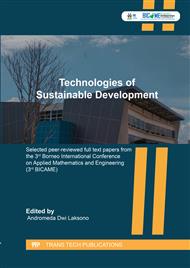[1]
International Labour Organization, Meningkatkan Keselamatan dan Kesehatan Pekerja Muda,, (2018).
Google Scholar
[2]
N. Xia, Q. Xie, X. Hu, X. Wang, and H. Meng, A dual perspective on risk perception and its e ff ect on safety behavior : A moderated mediation model of safety motivation, and supervisor's and coworkers' safety climate,, Accid. Anal. Prev., vol. 134, no. February 2019, p.105350, (2020).
DOI: 10.1016/j.aap.2019.105350
Google Scholar
[3]
N. Xia, Q. Xie, X. Hu, X. Wang, and H. Meng, A dual perspective on risk perception and its effect on safety behavior: A moderated mediation model of safety motivation, and supervisor's and coworkers' safety climate,, Accid. Anal. Prev., vol. 134, no. November 2019, p.105350, (2020).
DOI: 10.1016/j.aap.2019.105350
Google Scholar
[4]
T.R. Lennart Sjöberg, Bjørg-Elin Moen, Explaining risk perception. An evaluation of the psychometric paradigm in risk perception research,, (2004).
Google Scholar
[5]
C.M. Wang, B.B. Xu, S.J. Zhang, and Y.Q. Chen, Influence of personality and risk propensity on risk perception of Chinese construction project managers,, JPMA, vol. 34, no. 7, p.1294–1304, (2016).
DOI: 10.1016/j.ijproman.2016.07.004
Google Scholar
[6]
R.T. Steinbakk, P. Ulleberg, F. Sagberg, and K.I. Fostervold, Speed preferences in work zones: The combined effect of visible roadwork activity, personality traits, attitudes, risk perception and driving style,, Transp. Res. Part F Traffic Psychol. Behav., vol. 62, p.390–405, (2019).
DOI: 10.1016/j.trf.2019.01.017
Google Scholar
[7]
W.D. Taylor and L.A. Snyder, The influence of risk perception on safety: A laboratory study,, Saf. Sci., vol. 95, p.116–124, (2017).
Google Scholar
[8]
S.S. Man, A.H.S. Chan, and H.M. Wong, Risk-taking behaviors of Hong Kong construction workers – A thematic study,, Saf. Sci., vol. 98, p.25–36, (2017).
DOI: 10.1016/j.ssci.2017.05.004
Google Scholar
[9]
J.C. Magee, F.J. Milliken, and A.R. Lurie, Power differences in the construal of a crisis: The immediate aftermath of september 11, 2001,, Personal. Soc. Psychol. Bull., vol. 36, no. 3, p.354–370, (2010).
DOI: 10.1177/0146167209360418
Google Scholar
[10]
M.J. Tear, T.W. Reader, S. Shorrock, and B. Kirwan, Safety culture and power: Interactions between perceptions of safety culture, organisational hierarchy, and national culture,, Saf. Sci., vol. 121, no. November 2018, p.550–561, (2020).
DOI: 10.1016/j.ssci.2018.10.014
Google Scholar
[11]
S. Oah, R. Na, and K. Moon, The Influence of Safety Climate , Safety Leadership, Workload, and Accident Experiences on Risk Perception : A Study of Korean Manufacturing Workers,, Saf. Health Work, vol. 9, no. 4, p.427–433, (2018).
DOI: 10.1016/j.shaw.2018.01.008
Google Scholar
[12]
A. Raziq and R. Maulabakhsh, Impact of Working Environment on Job Satisfaction,, Procedia Econ. Financ., vol. 23, no. October, p.717–725, (2015).
DOI: 10.1016/s2212-5671(15)00524-9
Google Scholar
[13]
T. Kawada and T. Otsuka, Relationship between job stress, occupational position and job satisfaction using a brief job stress questionnaire (BJSQ),, Work, vol. 40, no. 4, p.393–399, (2011).
DOI: 10.3233/wor-2011-1251
Google Scholar
[14]
I.L. Nunes, FAST ERGO-X - A tool for ergonomic auditing and work-related musculoskeletal disorders prevention,, Work, vol. 34, no. 2, p.133–148, (2009).
DOI: 10.3233/wor-2009-0912
Google Scholar
[15]
J.P. Rushton, R.D. Chrisjohn, and G.C. Fekken, The altruistic personality and the self-report altruism scale. Personality and Individual Differences,, Pers. Individ. Dif., vol. 2, no. 4, p.293–302, (1981).
DOI: 10.1016/0191-8869(81)90084-2
Google Scholar
[16]
F.M. Andrews et al., Measures of Personality and Social Psychological Attitudes. (1991).
Google Scholar
[17]
S.P. Whiteside and D.R. Lynam, The Five Factor Model and impulsivity: using a structural model of personality to understand impulsivity,, Pers. Individ. Dif., vol. 16, no. 3, p.329–341, (2000).
DOI: 10.1016/s0191-8869(00)00064-7
Google Scholar
[18]
M. Murguía-Romero, R. Jiménez-Flores, A.R. Méndez-Cruz, and R. Villalobos-Molina, Improving the body mass index (BMI) formula with heuristic search,, Proc. Spec. Sess. - Revis. Pap. 11th Mex. Int. Conf. Artif. Intell. 2012 Adv. Artif. Intell. Appl. MICAI 2012, no. June 2015, p.100–104, (2012).
DOI: 10.1109/micai.2012.24
Google Scholar
[19]
B. Pandit, A. Albert, Y. Patil, and A.J. Al-Bayati, Impact of safety climate on hazard recognition and safety risk perception,, Saf. Sci., vol. 113, no. November 2018, p.44–53, (2019).
DOI: 10.1016/j.ssci.2018.11.020
Google Scholar
[20]
J. Hair Jr, G.T. Hult, C. Ringle, and M. Sarstedt, A Primer on Partial Least Squares Structural Equation Modeling (PLS-SEM) - Joseph F. Hair, Jr., G. Tomas M. Hult, Christian Ringle, Marko Sarstedt. (2016).
DOI: 10.1080/10705511.2022.2108813
Google Scholar
[21]
L.T. Hu and P.M. Bentler, Cutoff criteria for fit indexes in covariance structure analysis: Conventional criteria versus new alternatives,, Struct. Equ. Model., vol. 6, no. 1, p.1–55, (1999).
DOI: 10.1080/10705519909540118
Google Scholar


